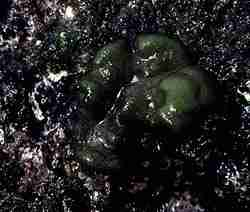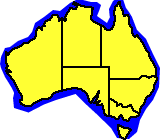|
|

Globe Algae Colpomenia sinuosa
Form:
 The
Globe Algae is irregular in shape, globe-shaped, and crinkled in shape.
This algae is sometimes twice as high as it is broad.
The
Globe Algae is irregular in shape, globe-shaped, and crinkled in shape.
This algae is sometimes twice as high as it is broad.
It's skin membrane is a thin, crisp wall filled with water and air.
The plant is usually attached to other algae, seagrasses or rock by a small, crusty base. Globe Algae is also called Bubbleweed.
Colour:
Globe Algae is light yellow or honey-brown to dark brown in colour.
Phylum: |
Phaeophyta |
Author: |
Mertens ex Roth: Derbes & Solier 1851 |
Family: |
Scytosiphonaceae |
Size: |
40 - 60 mm wide |
Distribution:
 Widely
found in most oceans. Found all around Australia, but preferring tropical
and temperate shores. It seems to be more common in summer.
Widely
found in most oceans. Found all around Australia, but preferring tropical
and temperate shores. It seems to be more common in summer.
Habitat:
Occurs from mid-tide level and below, being common in rock pools. Often attached to other algae, or seagrasses such as Posidonia in estuaries.
Biology:
This is the most common species of globe-shaped algae found attached to other plants in southern Australia.
Questions:
Which environments does this algae most commonly prefer ? Why ?
Does this algae prefer to live in areas with heavy wave action ? Why ?
References:
Bennett, I. (1987) W.J. Dakin's classic study: Australian Seashores. p.246, Angus & Robertson, Sydney.
Davey, K. (1998) A Photographic Guide to Seashore Life of Australia. p.40, New Holland, Sydney.
Edgar, G.J. (1997) Australian Marine Life: the plants and animals of temperate waters. p.172, Reed Books, Kew.
Quinn, G.P., Wescott, G.C. & Synnot, R.N. (1992) Life on the Rocky Shores of South-Eastern Australia: an illustrated field guide. p.61, Victorian National Parks Association, Melbourne.
Marine Research Group of Victoria (1984) Coastal Invertebrates of Victoria: an atlas of selected species. p.104, Museum of Victoria, Melbourne.
Underwood, A.J. ( ) Science Field Guides: Barnacles. p.11, Reed Education, Sydney.
Underwood, A.J. & Chapman, M.G. (1993) Seashores: a beachcomber's guide. p.36, New South Wales University Press, Sydney.
Ectocarpus
Sausage Weed
Doubling Weed
Padina
Globe Algae
Leather Kelp
Neptune's Necklace
Strap Weed
Home
Page
Taxonomy
Biogeography
Rocky Shores
Tidal Levels
Intertidal Zonation
Environmental Factors
Biological
Factors
Feeding Relationships
Activities
Glossary
References
 Life
on Australian Seashores
Life
on Australian Seashores
by Keith Davey (C) 2000
Learning Consultant
- Media
The University of Newcastle
email at australian_seashores@hotmail.com
Scientific Consultant: Phil
Colman
site created 01.01.98 : updated 01.04.2000